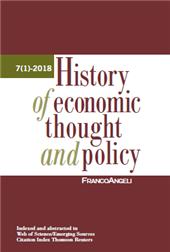Between Ricardo and Wagner : A Case Study on the History of Banking Legislation (1876-1879)
81-97 p.
This paper provides a case history of the attempt by the first Italian left-wing government to regulate the banks' issue system in the second half of the 19th century. From the point of view of banking policy, behind the gradualist approach to institutional changes lay an "eclectic" theory on the value of money between Ricardo and Wagner, which also characterized the action of the Minister of Economy Majorana in the first three years of the left-wing Government. The "middle way" favored by the Minister for banking regulation was largely inspired by the financial policy developed by Chase, Secretary of the Treasury in President Lincoln's cabinet, during the American Civil War. These measures formed a model of "moderate" free banking, in the balance between hard and soft money, between the money issued by the State and that produced by private banks, and indeed between decentralization and centralization of the monetary institutions.
This policy proved able to unify the currency in the Union on a permanent basis, appropriate to control the very strong inflationary pressures triggered by military spending, also financed by issue of greenbacks, but, above all, opportune to create a market for government bonds. In the case of Italy, examined here, regulatory response proved ineffective due both to the many changes that had been made to the project during parliamentary approval, severely compromising the rationality and consistency of Majorana's original project, and to the failure to implement it. The insufficient legislation introduced was not able to stem the banking crisis, which became systemic in the early1890s. [Publishers' text].
Fa parte di
History of Economic Thought and Policy : 1, 2018-
Articoli dello stesso fascicolo (disponibili singolarmente)
-
Informazioni
Codice DOI: 10.3280/SPE2018-001004
ISSN: 2280-188X
PAROLE CHIAVE
- Banking Legislation, Italy 1876-79, Ricardo, Wagner, Majorana, Premium on bullion theory


